The United States of America and Cambodia have had a complicated history during the years before and after independence. From goodwill and development to war and destruction and later aid and trade, the modern Cambodian nation has been interwoven with the politics of the world superpower, cold war realpolitik and the whims of a monarch.
As events begin marking diplomatic relations get underway, History Steve researched some of the most important 100+ dates of events which shaped the relationship between the world’s largest economy and the kingdom.
Despite the ups and downs between the two nations over the past 7 decades, support for the US still remains strong among Cambodian people, with the approval ratings for US policy remaining at some of the highest in the region.
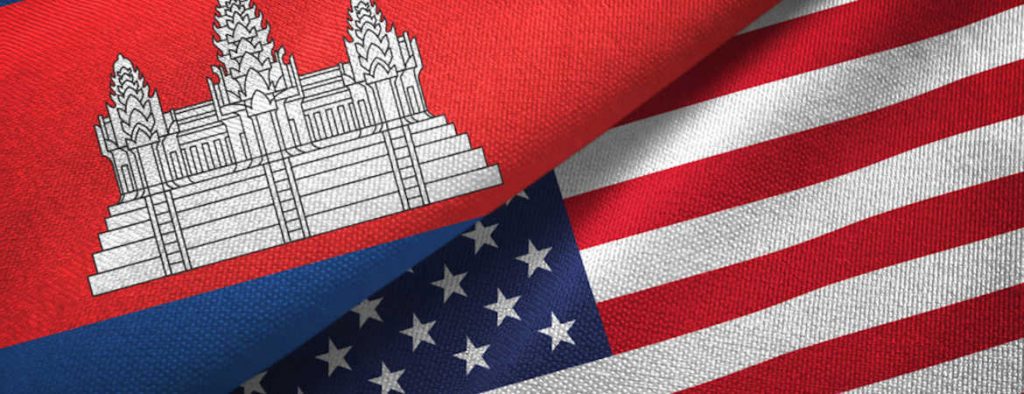
May 1950: President Harry Truman approves $20 million in economic and military aid to Cambodia, an amount that would increase significantly over the decade.
11 July 1950: Formal relations between the then French Protectorate of Cambodia and the United States of America begin when Donald R. Heath presents his credentials.
14 November, 1950: The US legation sets up inside the Hotel Le Royal.
1951/52: King Sihanouk sends President Truman a rare white elephant (the animal reportedly died in Cape Town while being transited).
25 June, 1952: US legation upgraded to embassy status. Donald R. Heath becomes the first US Ambassador to Cambodia.
17 April, 1953: First recorded visit of King Sihanouk to USA.
9 November 1953: Cambodia declares independence from France.
April 1954: Several Viet Minh battalions cross the border into Cambodia. They mostly withdrew (along with French) the following October after the Geneva Conference.
July 20, 1954: Cambodia agrees neutrality, vowing not to join any military alliance “not in conformity with the principles of the Charter of the United Nations” or to allow the basing of foreign military forces on its territory “as long as its security is not threatened.”
February 1955: Secretary of State John Foster Dulles visits Phnom Penh (the highest level official visit at the time) to meet with King Sihanouk and discuss defense plans. A military defense agreement was signed in May.
22 March 1955: The Sangkum Reastr Niyum (Popular Socialist Community) led by Prince Norodom Sihanouk founded. The prince had abdicated the throne on 2 March.
19 July 1958: Cambodia formally recognizes the People’s Republic of China. In protest US Ambassador Carl W. Strom temporarily recalled.
1955-1963, the United States provides $409.6 million in economic grant aid and $83.7 million in military assistance to Cambodia. ‘Khmer-American Friendship Highway’ now known as National Road #4 between Phnom Penh and Sihanoukville built with US aid inaugurated in 1959.
“This is a highway of friendship, built through the cooperative efforts of Americans and Khmers who have worked in a spirit of liberty and fraternity toward the goal of economic independence of this country.” said Prince Sihanouk.
“This highway, built by joint efforts of Cambodian and the United States of America, is the symbol of the friendship of the peoples of our two countries, and of our mutual desire for a free, independent prosperous Cambodia.” said President Eisenhower

15 June 1962: Following Sihanouk’s hiring of lawyer and former U.S. Secretary of State Dean Acheson to represent Cambodia, Prasat Preah Vihear is recognized as Cambodian territory and ownership is given up by Thailand.
August 1963: After an assault by South Vietnamese forces on a Cambodian guard post, diplomatic relations between Cambodia and South Vietnam were ended. A few days later, the Soviet Union sent four aircraft and 24 anti-aircraft guns to Cambodia, marking the first non-Western military aid to the country. Relations between the United States and Cambodia continue to sour.
November 22, 1963: President John F. Kennedy assassinated in Dallas. After brief a mourning, Sihanouk later organised concerts and granted civil servants extra leave time to celebrate the occasion, accusing JFK of attempts to destabilize Cambodia. When the US government protested Sihanouk’s celebrations, he responded by recalling the Cambodian ambassador to the US, Nong Kimny. Ambassador Sprouse was then returned to Washington.
Early 1964: Sihanouk signed a secret agreement with North Vietnam and the Viet Cong, allowing Chinese military aid be delivered to them via the port of Sihanoukville, known as the ‘Sihanouk Trail’. The better known ‘Ho Chi Minh Trail’ also cut through parts of Eastern Cambodia.
9 July, 1964: Randolph A. Kidder was appointed as U.S. Ambassador to Cambodia, but the Prince refused to accept his credentials. By the end of 1964, there were only 12 official representatives of the United States in Cambodia; a year earlier there had been 300.
1965: USAF begins some bombing of North Vietnamese targets on the Cambodia-Vietnam border.
26th April 1965: The US Embassy street stormed by a mob of 20,000 Cambodian students. They hurled rocks, ink bottles and other missiles at the building and ripped down the American flag. Authorities said the demonstration was touched off by U.S. cross-border air attacks that had killed Cambodian citizens and by a slanderous article about Prince Sihanouk and his wife Monique in the April 5th issue of Newsweek magazine.
May 1965: Diplomatic relations between Cambodia and The United States broken off by Cambodia.
2 April 1967 – 8 April 1968: Samlaut uprising in Battambang province. This anti-government revolt is seen by many as the beginning of the Cambodian revolutionary movement following the crackdown by Sihanouk’s forces. The prince blames leftist elements, which he calls the ‘Red Khmer’.
September 1967: After relations with China sour following communist propaganda, Sihanouk closes the Cambodia–Chinese Friendship Association and enters into dialogue with the US.
October 1967: In an attempt to rekindle relationship with the USA, Sihanouk invites Jackie Kennedy to visit Angkor Wat.

8 January, 1968: Sihanouk meets with Chester Bowles, US Ambassador to India in Phnom Penh. Talks of a resumption of ties begin. Privately Bowles was told that Cambodia would not complain if Vietnamese targets were attacked when they crossed over into Khmer territory, which was known as ‘hot pursuit’, on the condition no Cambodians were hurt.
20 January, 1969: Richard Nixon sworn in as president.
30 January 1969: Chairman of the Joint Chiefs Earle Wheeler suggests to the president that he authorize the bombing of the Cambodian sanctuaries used by NVA and Viet Cong forces. He was seconded on 9 February by the U.S. commander in Vietnam, General Creighton W. Abrams.
18 March 1969: 26 May 1970: Operation Menu, a covert strategic bombing campaign by the USAF over eastern Cambodia commences. SAC flew 3,800 B-52 sorties against North Vietnamese targets, and dropped 108,823 tons of ordnance.
2 April, 1969: Although bombing continues secretly, the United States issues a border declaration recognizing Cambodia’s sovereignty, independence, neutrality and territorial integrity.
June 1969: Cambodia gives diplomatic recognition to the Provisional Revolutionary Government of the Republic of South Vietnam (PRGSV). Sihanouk also formally admits to a North Vietnamese presence inside the country.
July 2, 1969: Formal relations reestablished.
11 March 1970: Large scale protests and riots against both North and South Vietnamese embassies in Phnom Penh.
18 March 1970: The National Assembly votes to depose Sihanouk. Lon Nol becomes president of the Khmer Republic. The Sangkum Reastr Niyum (Popular Socialist Community) dissolved.
5 July 1970 : Sihanouk sentenced to death in absentia by a military court. The prince remains in exile in North Korea and China.
(September?) 1970 : Vice President Spiro Agnew visited Cambodia and meets with Lon Nol.
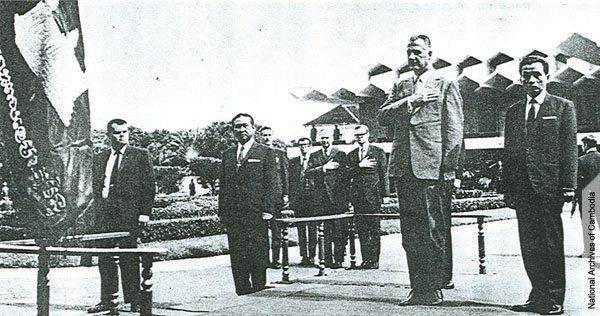
1970–75: The United States provided $1.18 billion in military assistance to government forces in their fight against the Khmer Rouge, as well as $503 million in economic assistance.
24 to 29 April 1970: Operation Patio. B-52 bombers authorized to strike targets in northeastern Cambodia extending 8 miles (13 km) west of the South Vietnamese border. On 25 April, the boundary was extended to a depth of 18 miles (29 km). 156 sorties were flown.
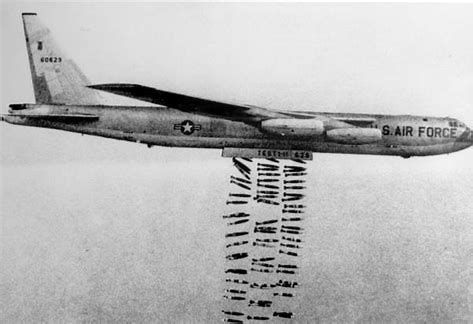
29 April – 22 July 1970: The Cambodian campaign. President Nixon approves an invasion of Cambodia with 13 major ground operations conducted by the Army of the Republic of Vietnam (ARVN) between 29 April and 22 July and by US forces between 1 May and 30 June.
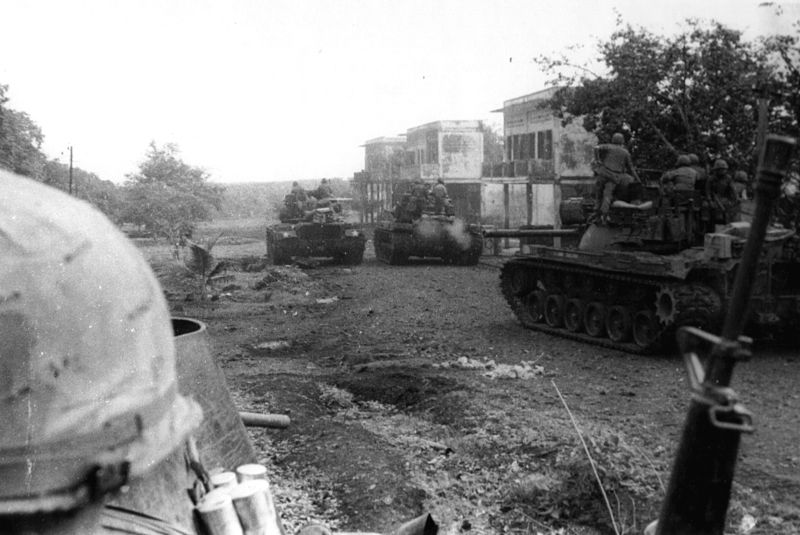
4 May 1970: Four students protesting about the escalation of the war shot and killed by the National Guard at Kent State University, Ohio.
19 May 1970 – 15 August 1973: Operation Freedom Deal. A systematic bombing campaign across much of Cambodia by the USAF. Most targets were in the east.
20 August – 3 December 1971: Operation Chenla II. Khmer National Armed Forces (FANK) with US air support launch surprise attack on communist forces. 10 battalions of FANK troops decimated.
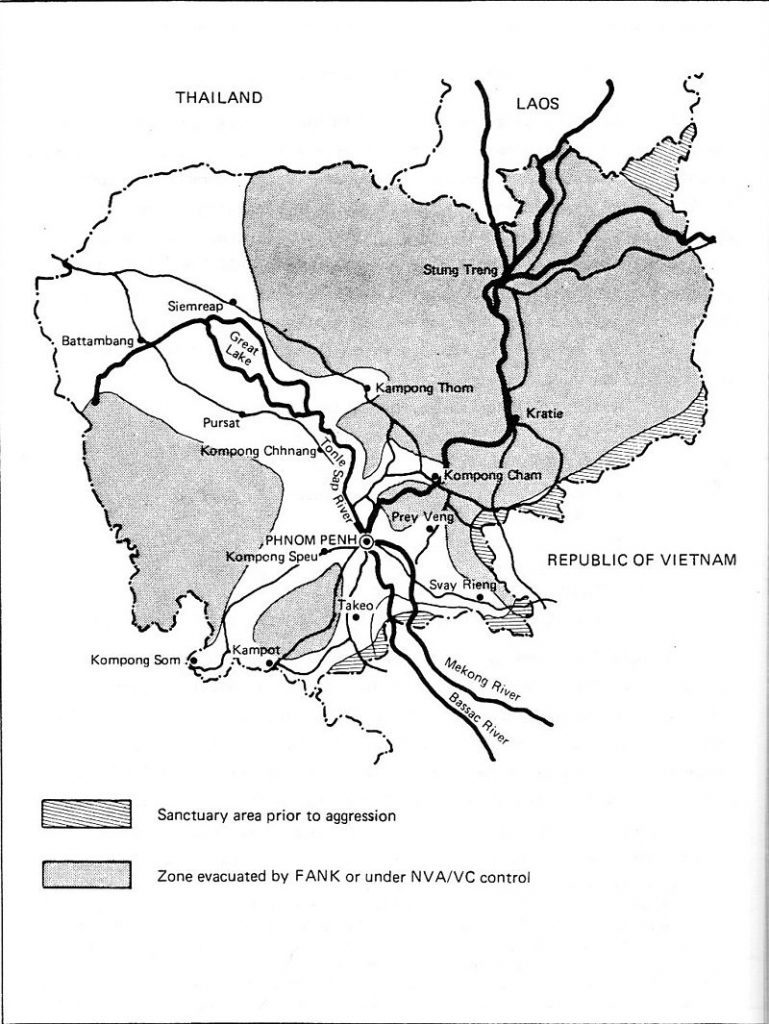
February 1973: Sihanouk travels to Hanoi, where he starts on a long journey with Khieu Samphan and other Khmer Rouge leaders into ‘liberated’ teritory held by the communists in the northeast. Under constant threat of US air attack, the convoy proceeded along the Ho Chi Minh trail and reached the Cambodian border at Stung Treng Province the following month. From there, they traveled across the provinces of Stung Treng, Preah Vihear, and Siem Reap.
1 July 1973: The Case–Church Amendment prohibited further U.S. military activity in Vietnam, Laos and Cambodia unless the president secured Congressional approval in advance.
7 November 1973: President Richard Nixon’s controversial bombing actions led to the War Powers Resolution, a federal law intended to check the U.S. president’s power to commit the United States to an armed conflict without the consent of the U.S. Congress.
1974: Dr. Kenneth Quinn (later Ambassador to Cambodia) on assignment along the Cambodian border in Vietnam, is the first to report on the genocidal policies of Pol Pot and the Khmer Rouge.
17 February 1975: Khmer Republic besieged in Phnom Penh. The United States quickly mobilised an airlift of food, fuel and ammunition into the city but as US support for the Khmer Republic was limited by the Case–Church Amendment, BirdAir and ‘The Flying Tiger Line’, under contract to the US Government, controlled the airlift with a mixed fleet of C-130 and DC-8 planes, flying 20 times a day into Pochentong.

22 March 1975: Khmer Rouge rockets hit two supply aircraft, forcing the US Embassy to announce on 23 March a suspension of the airlift until the security situation improved. The Embassy, realizing that the Khmer Republic would soon collapse without supplies, reversed the suspension on 24 March and increased the number of aircraft available for the airlift.
1 April 1975: The Khmer Rouge overrun Neak Luong and Ban-am, the last remaining FANK positions on the Mekong. The Communists could now concentrate all their forces on Phnom Penh. Premier Lon Nol resigns the same day and goes into exile in Hawaii via Indonesia. The final collapse of the Khmer Republic is imminent
12 April 1975: Operation Eagle Pull. US citizens and allied Cambodians evacuated from Phnom Penh via Ponchentong airport. US Ambassador John Gunther Dean will be the last to hold the job until 1993.

17 April 1975: The Khmer Rouge enter Phnom Penh bringing the Cambodian Civil War to an end.
12 May 1975: Khmer Rouge forces seize the SS Mayaguez off Koh Tang, which sees the US bomb Sihanoukville and the final battle involving US troops of the Vietnam war period takes place. US losses see 15 killed in action, 3 captured and later killed, 23 killed en route in a helicopter failure,
50 wounded and 3 CH-53 helicopters destroyed.
23 May 1975: President Gerald Ford’s administration passes the Indochina Migration and Refugee Assistance Act, allowing around 130,000 people from Laos, Cambodia and Vietnam to settle in the USA.
7 January 1979: Vietnamese forces and Cambodian allies enter Phnom Penh, ending the Khmer Rouge regime.
2 June 1982: Coalition Government of Democratic Kampuchea (CGDK) formed. The president of the coalition was Prince Norodom Sihanouk, the prime minister was the KPNLF leader Son Sann and the foreign secretary was PDK (Khmer Rouge) leader Khieu Samphan. The CGDK was allowed to retain the Cambodian/Kampuchean seat in the United Nations (with US support) on the premise that it was a legitimate Cambodian government in contrast to the pro-Vietnamese People’s Republic of Kampuchea.
1984: The Killing Fields propels the suffering of the Khmer Rouge era to global audiences and wins 3 of 7 Oscar nominations.

8 August, 1985: For the first time, U.S. non-lethal aid to the non-communist resistance would be overt, reaching a total of $15 million over the next three years, after a campaign by Representative Stephen Solarz, a Democrat from New York with a keen interest in developments in Cambodia.
Mid-Late 1980’s: Around 150,000 Cambodians refugees from Thai border camps settle in the USA.
1987: One of the Reagan Doctrine’s principal architects, The Heritage Foundation’s Michael Johns, visited with Sonn Sann and Sihanouk forces in Cambodia in 1987 and returned to Washington urging expanded United States support for the KPNLF and the Sihanouk resistance forces as a third alternative to both the Vietnamese-installed and supported Cambodian government and the Khmer Rouge, which also was resisting the government.
Late 1980s-early 1990s. Sonn Sann and Sihanouk opposition forces, then known as the KPNLF and FUNCINPEC, drew some military and financial support from the United States, under the Reagan Doctrine.
15 January 1990: In Paris. John Bolton, U.S. Assistant Secretary of State for International Organizations (later President Trump’s security adviser), and Richard Solomon, U.S. Assistant Secretary of State for East Asian and Pacific Affairs, present a chronology for transferring authority to the UN and preparing for elections.
October 23, 1991: USA among 19 signatory countries of the Paris Peace Agreements, officially ending the Cambodian-Vietnamese war.
11 November 1991: United States opens a liaison office in Phnom Penh and appoints Charles H. Twining as U.S. Representative. The US announces that it would end economic sanctions and begin providing aid to Cambodia for the first time in 15 years. By 1992, the U.S. Agency for International Development (USAID) would re-open its permanent mission to Cambodia, and the agency’s total budget for the decade would reach $264 million.
14 November 1991: After 13 years in exile, Sihanouk returns, riding from the airport into Phnom Penh in a 1963 Chevrolet Impala convertible.
3 January, 1992: US lifts its embargo against Cambodia, opening the way for economic relations.
28 February 1992: United Nations Security Council resolution 745, adopted unanimously on the establishment of the United Nations Transitional Authority in Cambodia (UNTAC). US provides around 30% of budget. Only 50 non-combat US servicemen in the country. Unknown number of civilians and NGO workers.
23 May 1993: Elections see 90% turnout won by FUNCINPEC. Power sharing agreement quickly arranged with CPP.
24 September 1993: Norodom Sihanouk becomes king again. The United States and the Kingdom of Cambodia establish full diplomatic relations after the UNTAC sponsored election.
17 May, 1994, U.S. Representative Charles H. Twining presents his credentials as U.S. Ambassador.
1996: American Chamber of Commerce (AMCHAM) Cambodia established.
30 March, 1997: Ron Abney, an American citizen and Chief of the Delegation of the International Republican Institute injured in grenade attack on opposition politician Sam Rainsy. 16 Cambodians died, over 100 more wounded. An FBI investigation was launched, although the perpetrators were never identified.
Mid-late 1997: Following political violence between CPP and FUNCINPEC forces, the United States suspends bilateral assistance to the Cambodian Government. CPP takes full control of the government.
15 April, 1998, Pol Pot dies of natural causes, effectively ending the Khmer Rouge movement.
30 May 1999: Prime Minster Hun Sen’s eldest son Manet becomes the first Cambodian ever to graduate from the prestigious West Point Military Academy.

31 August, 1999: Kent M. Wiedemann presents his credentials as U.S. Ambassador. With the civil war over, United States restores bilateral development aid.
1999: Agreements made on favourable terms for Cambodian garment exports to US market, in return for labour reforms.
November 2000: President Bill Clinton visits Vietnam, the first since Nixon in 1969. As a humanitarian gesture to aid UXO clearance in Cambodia, he released a classified database detailing all known bombing raid targets that had taken place over Cambodia during the Vietnam war.

2001: Sichan Siv becomes the United States ambassador to the United Nations Economic and Social Council until 2006. Born in Pochentong in 1948. His entire family – 15 in total, including his mother, were killed during Pol Pot’s reign of terror. He arrived in the United States in 1976, and enrolled in the Master of International Affairs Program at Columbia University with a full scholarship. He became a US citizen in 1982, and was a volunteer in George H.W. Bush’s 1988 presidential campaign and was appointed as his deputy assistant in 1989.
2002: The two countries sign a Memorandum of Understanding on repatriation of Cambodians living in the US who were convicted of felonies. By 2017, around 600 Cambodian nationals who were permanent U.S. residents had been deported to Cambodia. That number has since increased.
18 June 2003: U.S. Secretary of State Colin Powell visits Cambodia and meets with leaders of the three leading political parties. Powell calls for all parties to receive fair and equal coverage in the country’s media for upcoming election.
17 January, 2006: New US Embassy building opens.
2006: Peace Corps projects in Cambodia begin. The first 29 volunteers sworn in on 17 April, 2007.
4 December 2006: Former President Bill Clinton visits Cambodia. His foundation helps tackle the HIV/AIDS epidemic.
20 January, 2009: Carol A. Rodley presented her credentials and becomes the first female ambassador to Cambodia.
2009: Between 2000-2009 US Agency for International Development’s budget quadrupled in size, reaching a total expenditure of over $470 million.
2010: Cambodia and USAF hold first ‘Angkor Sentinel’ joint exercises in the kingdom.

19 November 2012: President Obama visits Cambodia and has what was described in the press as a ‘tense meeting’ with the Prime Minister.
15 October, 2012: Sihanouk, now the King Father after abdicating in 2004, dies in Beijing aged 89. Ambassador William Todd represents the US government at his funeral.
22 March 2015: First Lady Michelle Obama visits Siem Reap to promote education of girls.
16 January 2017: Angkor Sentinel joint military exercises canceled during planning for the 7th annual event.
3 February, 2017: United States Ambassador William Heidt tells his Cambodian counterparts that Cambodia should work on a deal with the United States to pay its $500 million war debt from the Lon Nol period.
23 August 2017: US State Department-funded National Democratic Institute ordered to stop its operations and expel all foreign staff within 7 days.
3 September 2017: Opposition leader Kem Sokha arrested on charges of conspiring with the United States to overthrow the government.
14 September 2017: Cambodian co-operating in the search for US servicemen MIA during Vietnam war suspended. Peace Corps ‘advised’ to leave Cambodia.
November 2017: US under the Trump Administration withdraws $1.8 million in assistance to the National Election Committee (NEC).
7 December 2017: US announces visa restrictions on some Cambodian officials and their families.
17 September 2018: Ambassador Chum Sounry meets with President Trump. “The economic development your country has achieved during this time is astounding, and we are proud to be a partner in growth,” Mr Trump was quoted as saying. “We know Cambodia has the potential for much greater development in the future, and we are excited to work together on challenges and opportunities.”
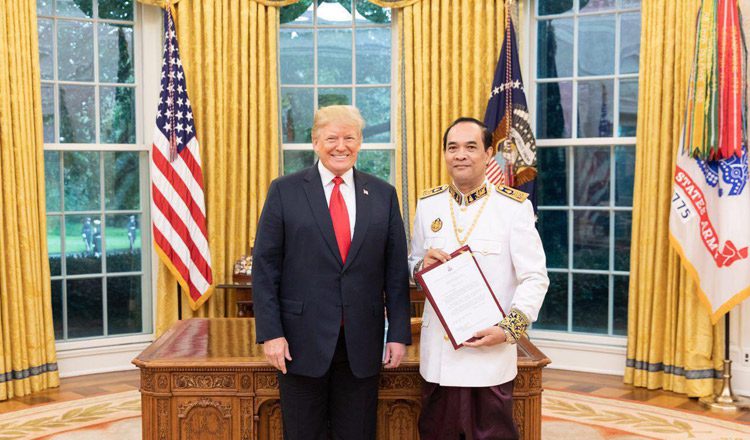
16 October 2018: US allowed to resume search for servicemen MIA from Vietnam war.
28 November, 2018: William A. “Bill” Heidt ends his role as US Ambassador, leaving the role vacant.
10 January 2019: Senators Ted Cruz and Chris Coons introduce the Cambodia Trade Act, which would require the Trump administration to review the General System of Preferences (GSP). Cambodia exported more than $400 million worth of products duty-free to the US in 2017, according to Ken Loo of the Garment Manufacturers Association in Cambodia.
3 April 2019: Republican Washington State Senator Doug Ericksen and former state Rep. Jay Rodne, register as foreign agents in filings with the U.S. Justice Department, disclosing the $500,000-a-year contract given to their company, PacRim Bridges by the Cambodian government.
July 2019: US Representative Ted Yoho succeeds in pushing his Cambodia Democracy bill through the United States House of Representatives from where it will go to the Senate for further debate and a vote which may or may not see the bill passing into law. If passed, the Cambodia Democracy Act will create a requirement for the American president to impose sanctions on individuals deemed responsible by him for acts undermining democracy in Cambodia. Yoho introduced a similar bill the previous year, which passed the House but did not survive the Senate.
8 August, 2019: Due to issues in Washington, including the Federal Government Shutdown, there was no resident Ambassador for over 9 months. W Patrick Murphy, who was nominated in January, finally takes the job.
28 August 2019: Cambodian military leaders meet with US counterparts and stress there will be no Chinese naval base at Ream, following media reports.
12 September 2019: Republican suporting Khmer-American Elizabeth Heng narrated a controversial advertisement comparing Alexandria Ocasio-Cortez’s ‘socialism’ to the Pol Pot regime.
January 2020: Ambassador Murphy opens 70 year celebrations.

* Some of the events featured will be given full features in the weekly history articles.
Sources: US Embassy of Cambodia, US Congress, Wikipedia, Philip Coggan, VoA and various news media.

One thought on “70 Years Of US-Cambodia Relations In 100 Dates”